|
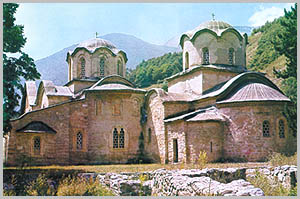
-Kosovo and Metohija (Old Serbia) the cradle of Serbian statehood
and spiritual life
- The Kosovo battle
- The Turkish rule -
the beginnings of the movements of population and the islamisation
-The liberation
movement of the Serbs and the first migrations of the Serbian people
- The penetration of
the Albanians into Serbian territories
- The terror against
the Serbs in the XIX century
- The liberation
wars of Serbia and Montenegro
- The Prizren League
- The Persecutions
of the Serbs and the change of the ethnic structure of Kosovo
-The Balkan War
- The London Peace
Conference
- The creation of
the Fascist protectorate "Greater Albania"
- Kosovo and
Metohija during the Second World War
- The persecution of
Serbs since the ‘sixties until the ‘eighties
- The real objective
of the slogan "Kosovo-Republic"
- The Islamic
extremism in Kosovo and Metohija today
- The import of
terrorism from Albania
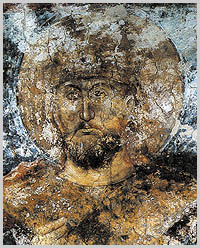
I - Kosovo
and Metohija (Old Serbia) the cradle of the Serbian statehood and spiritual life
The region of Kosovo and Metohija was populated, since the early
medieval ages, by homogenous Serbian population. Under the Byzantine rule, until the final
inclusion in the Serbian Medieval State of the House of Nemanjici by the end of the 12th
and by the beginning of the 13th century, Kosovo and Metohija was an ethnically Serbian
country. This is confirmed by the historical documents (the Charters of the Serbian
rulers), and especially by antroponomial (analysis of personal names) and toponomastic
research; the old toponims of Kosovo and Metohija are mainly of Slav origin. The very name
of the region Kosovo and Metohija is derived from the Serbian words "kos", which
would literally mean "the field of the bird kos" (blackbird) and
"metoh", which means "church estate". Mobile groups of cattle breeders
of Albanian nationality, mainly Roman Catholics, represented a negligible percentage, some
2% of the total population, in the western parts of the region, at the mountains of the
present border region between Yugoslavia and Albania.
The situation in Kosovo and Metohija was not substantially changed
during the Turkish invasion in the ‘eighties and ‘nineties of the 14th century.
The ethnical relations remained the same, and the Serbian character of the region was not
challenged. The studies of original Turkish regulations (defters) from the 15th century
show that the line of the present state border between Yugoslavia and Albania, at its
northern sector, mainly coincides with the ethnical border between the Serbs and the
Albanians at that time. The Serbs achieved a very high degree of civilization especially
in the region of Kosovo and Metohija, and their European identity is based on those
achievements.
II The Kosovo Battle
The Osmanli invasion changed the life conditions of the Serbian people.
At the crossroads between eras, between the Serbian freedom and the slavery under the
Turks, there stands an event which became the symbol of the Serbian history: The Kosovo
Battle (June 28th, 1389).

According to its historical importance, and according to the place it
got in the historical memory of the people, this battle belongs to the great armed
conflicts in Europe, like the Kulikovo Battle (1380) and the Poitiers Battle (732), or, in
still more distant past, the Termopile battle (480 B.C.). The stubborn resistance of the
Serbs against the Osmanli invasion was crushed in the military and physical senses. The
death of the Serbian Prince Lazar with his army got in the historical conscience of the
people the meaning of a death of a martyr, but also of spiritual triumph in its heroic
sacrifice for the ideals of Christian civilization. For the Serbian nation, Kosovo and
Metohija represents the seal of its identity, the key of the lessons taught by its
history, the flag of the national freedom.
In spite of the tragic outcome of that battle - the greatest part of
the Serbian army was killed - the Serbian Empire lasted for 70 more years; Serbia was
finally occupied after the fall of Smederevo in 1459.
The fall of the Serbian Empire meant the destruction of the Christian
defense wall, and opened the way to the Turkish conquests which endangered Vienna several
times.
The conscience about the medieval state was an active element in the
struggle of the Serbian people for their liberation and unification, centuries later. The
conscience about Kosovo and Metohija as a mother Serbian country represents an inalienable
part of that conscience.
III The Turkish Rule - The Beginnings of the Movement of
the Population and the Islamisation
The Turkish invasion moved great ethnic masses in the Balkans. During
the 16th century, according to the official Turkish data, the Christians still represented
the absolute majority in comparison with the Moslems (Turks and islamised Albanians);
together with other Christian communities, which still existed as small groups of citizens
and cattle breeders, the number of Serbs represented 97% of the total population. The
situation of the people under the Turkish rule was very difficult, the influence of the
Turkish rule and of the islamisation was, as it is said by the Nobel Prize winner Ivo
Andric, "absolutely negative". This is confirmed and witnessed by all historical
sources. The Osmanli rule existed on the law of discrimination and of the absolute rule of
the Islam, with legal possibilities for individual and mass violence - until the physical
destruction of individuals and of entire regions.
The Region of Old Serbia (as the region of Kosovo and Metohija, and of
the neighboring regions was historically called), existed, therefore, in the 15th and 16th
centuries, as a Serbian land. Until the end of the 17th century, old spiritual centers
were activated in this region, and the strength of resistance of the Serbs grew. The
situation of the people under the Turks was very difficult, especially because of forced
islamisation.
These are the reasons of the permanent resistance and struggle of the
Serbian people for their national liberation, for their return to the European
civilization, but also the roots of the deep demographic changes which took place in the
18th and 19th centuries, which represent the basis of the present problem in Kosovo.
IV The Liberation Movement of the Serbs and the First Migrations of the
Serbian People
The Liberation movement of the Serbs grew, already since the end of the
16th century, from the permanent resistance of the people and from their refusal to accept
the Turkish-Islamic rule. The people was lead by the Church. During the great
Austro-Turkish wars 1683-1690 and 1717-1737, the Serbs participated in those wars in
masses in the very broad region of the Balkans. The North-Albanian Roman-Catholic Albanian
tribes fought together with them. Exposed to cruel reprisals of the Turks after the defeat
of the Austrians, the Serbs migrated in great waves to the north, from a huge territory,
from Central Macedonia to the Danube.
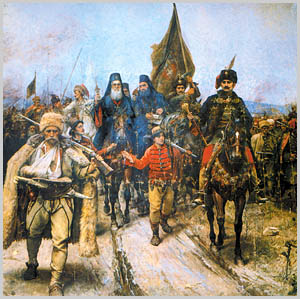
The Migration of
Serbs under the Patriarch Arsenije Carnojevic (painting by Paja Jovanovic)
The two "Great Migrations" of the Serbian people to
Austria, under the Patriarchs Arsenije III Carnojevic (1690) and Arsenije IV Jovanovic -
Sakabenta (1737), are an undeniable historical fact. In the first migration (1690), some
200.000 Serbs moved to Austria. The migrations obviously weakened the Serbian ethnic
element. However, it can be seen in the further development of events and in the
rebellions and insurrections that the remaining part of the Serbian people in those
territories was permanently renewed by individual or group Serbian migrations within the
borders of the Turkish Empire, and that that renewal was strong enough for armed
resistance. Kosovo and Metohija still represented, until the middle of the 18th century,
an ethnically homogenous and densely populated Serbian country, as it had been before the
Turkish invasion.
V The Penetration of the Albanians into Serbian
Territories
The Albanians penetrated into the south Slav countries only since the
beginning of the 18th century. The key of that penetration was the islamisation of the
Albanians in the 16th century, which included at least 50% of the total Albanian
population. The penetration was reinforced by the forced islamisation of the Serbs.
The settlement of the Albanians was mainly achieved: towards Nis and
Sophia by the end of the 18th century (some 50 kilometers of Sophia!), towards Skoplje and
Veles, and to the north - towards Bosnia via the Novi Pazar Sanjak
(territorial-administrative unit). The poor economic conditions in the mountainous areas,
and in the arid mountains of the northern and central Albania were just the starting
impulse of that great movement. That migration became only with islamisation and with the
Turkish policy, a massive colonization of Kosovo and Metohija and the extermination of
the Slav population. These political circumstances brought the Albanians to the new
territory.
VI. The Terror Against the Serbs in the 19th Century
Kosovo was the objective of the Serbian liberation movement and of the
program of the national unification. That objective was expressed not only in the First
Serbian Insurrection 1804-1813, but also in a number of rebellions, insurrections and
rebels’ actions in Old Serbia itself. The main and most cruel tool of the Turkish
repression in the hands of the Turks were the Albanian settlers - Moslems, therefore all
liberation movements of the Serbs in Kosovo and Metohija became always conflicts between
Serbs and Albanians. At Kosovo and Metohija, during the Serbian insurrections in the
so-called Belgrade Pashaluk (administrative-territorial unit), there was a terror without
precedent, marked with the obvious plan of the extermination and exile of the Serbs from
the entire Old Serbia. During the 1850s and the 1860s, the genocide against the
Serbian people was confirmed by a great number of documents, of grievances to the Turkish
administration against the crimes of the Albanians and in the reports of the European
consuls (Bitolj, Skoplje, Prizren, Prishtina).
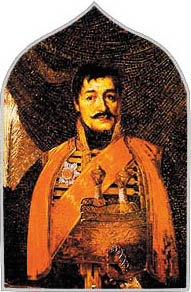
Djordje Petrovic -
Karadjordje, Head of the First Serbian Insurrection
VII The Liberation Wars of Serbia and Montenegro
The first liberation war of Serbia and Montenegro against Turkey,
1876-1877, and then the second one, represented the first serious and frontal clashes
between the Serbs and the Albanians. The Moslem Albanians fought against the Serbian
troops and defended the Turkish Empire, defending the country they had grabbed. The people
in Old Serbia was subsequently exposed to bloody revengers’ terror, which got an
organized character in the Albanian Prizren League
VIII The Prizren League
The nationalist Prizren League (1878) formulated for the first time the
concept of "Greater Albania".The program of the League was directed against the
Balkan states, indirectly against the European powers as well, who helped, although
modestly, the liberation endeavors of Serbia, Montenegro and Greece. Conquering and
revenging, anti-Serbian and anti-Slav, the League burdened the relations between the
Serbian and Albanian peoples during decades.
IX The Persecutions of the Serbs and the Change of the
Ethnic Picture of Kosovo
Three decades after the Berlin Congress, 1878-1912, were marked by
planned persecutions, by the physical destruction, displacement and forced exile of Serbs
from Turkey.It was only during that period that the ethnic equilibrium at the territory of
Old Serbia, i. e. of Kosovo and Metohija and of Northwestern Macedonia, was definitely
changed. During some thirty years some 400.000 Serbs left Kosovo and Metohija.
There were records of many murders, pillages and profanations of churches and cemeteries,
rapes and kidnappings of Serbian girls and women, even of small girls, attacks, plunders
and robberies, all with the same objective - to weaken the Serbian people and to expel
them from their own country.
Even Skoplje was in the hands of the Albanian rebels in 1912, although
the Albanians represented just a negligible minority at that time. A new and aggressive,
Islamic, anti-Serbian state started to appear at the southern borders of Serbia, always
ready to fig against the Christian Serbia.
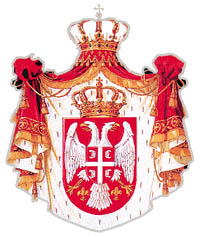
X. The Balkan War
The Balkan War, 1912, was waged by the Serbian State, together with
Montenegro, Bulgaria, and Greece, for the liberation from Turks.
At the Kosovo, i. e. Skodra War Area (1912), the allies met the open
enmity of the Albanian tribes and their armed resistance. The Autonomous Albania should
have been created not only at the insistence of Austria-Hungary and Italy, but also with
the consent of England, France and Russia. In the complex developments in 1912-1913,
Serbia had to struggle resolutely in order to assure the possession of the liberated
territories of Kosovo and Metohija, which was the objective of the aspirations of the
Austro-Hungarian Empire. The Serbian government was not ready to yield under the pressures
in the question of Kosovo and Metohija: " There is no such Montenegrin or Serbian
government which would or could cede to the Albanians or to any other this "Sacred
Land", of the Serbian nation", it was emphasized in the Memorandum addressed to
the European powers on January 21, 1913; regarding that question, "the Serbian
people does not want and can not make any concessions, transactions or compromises; no
Serbian government would do such a thing".
Albania proclaimed its independence in Valona, on November 28,
1912.
XI The London Peace Conference
The state of Albania was established at the basis of the decisions of
the London Conference 1912-1913. The Albanians expressed territorial pretensions against
Greece and Serbia already at that conference, although the attitude of the Big Powers was
quite clear. At that platform, the Albanians built their concept of permanent endangering
of those neighboring countries and of durable contesting of internationally recognized
borders.
The Kosovo Committee was established in November, 1918, in Skodra,
whose political and propaganda activities were directed against Yugoslavia. At the basis
of those activities, terrorist bands known as "Kacaks" were active in Kosovo and
Metohija between 1919 and 1924.
Even after the decision of the Ambassadors’ Conference, on
November 9, 1921, which recognized independent Albania, the territorial pretensions
against Serbia were still expressed. Since the mid-thirties, Albania became the area of
the Italian-Fascist strategic interests, and tolerated the anti-Yugoslav campaign of the
Kosovo and Albanian political emigration.
XII The Creation of the Fascist Protectorate
"Greater Albania"
After the occupation of Albania by Italy, in April, 1939, the joint
Italian-Albanian propaganda about the imminent creation of the "new" and
"greater" Albania got the dimensions of a very well organized movement. In that
way, a political opinion was formed in the majority of the Albanians that Fascism would
soon assure the change of the Albanian borders. With such feelings, with open enthusiasm,
the majority of the Albanians met, as the achievement of their national
objectives", the political and military defeat of Yugoslavia (April 1941) and of
Greece and the Fascist annexation of Kosovo, Metohija, Western Macedonia and eastern parts
of Montenegro by Albania.
XIII Kosovo and Metohija During the Second World War
The majority of the Albanian minority population in Yugoslavia and
Greece spent the war years in the situation of the so called "Albanian unity" in
the then created Fascist protectorate, the "Greater Albania". The majority of
them fought at the side of the Fascist forces; the Albanians in Yugoslavia continued to
terrorize the settled and autochtonous population, and that terrorism got the dimensions
of a genocide. In all regions of the "Greater Albania", the non-Albanian
population simply vanished, because of permanent violence and permanent pogroms. This was
done, during the Second World War, with great success, especially by the political
leadership of the Second Prizren League, established on September 16th, 1943.
Under the German occupation the terror was continued by the infamous
Kosovo Regiment (Regiment Kosova), devastating the areas from Pec to Djakovica and
Prizren, all over Kosovo and Metohija.. In the implementation of the basic aim of the
Second Prizren League - the defense of "all territories populated by
Squipetares" - they formed the volunteers’ SS- Division
‘Skenderbeg", with over 11.000 Albanians in it. In the intent to link as
strongly as possible the area of Kosovo and Metohija to Albania, the Albanians from those
regions committed many crimes against the Serbs and Montenegrins. The demographic and
ethnic picture changed also because of the permanent settlement of Albanians coming from
Albania, who settled in the homes and on the estates of the exiled population.The ethnic
cleansing of the Serbs got frightful dimensions.
XIV The Persecution of Serbs since the sixties until the
eighties
With the strict segregation (similar
to apartheid) of the Albanian people from the other peoples of Yugoslavia, with the
closing inside the walls of national, and especially language and cultural exclusiveness,
the Albanians in Yugoslavia were flooded by books, press, and especially textbooks from
Albania, often with open anti-Yugoslav theses and concepts. Kosovo and Metohija, as an
Autonomous Province of Yugoslavia, behaved increasingly in a secessionist way, in usurping
the right to communicate directly and to establish various relations with the PR of
Albania, to appear as the exclusive and compulsory intermediary in the contacts of all
other factors and institutions in the Republic and in the Federation with that neighbor
state.
The displacement of Serbs became more rapid and got the dimensions of
exile. Serbian monuments and cemeteries were also the objectives of attacks, even the
monuments from the anti-fascist struggle.Threats, blackmails, beatings, fires, rapes and
murders created in the Serbs the psychosis of complete legal, personal and property
insecurity, so that during that period, after 1968, many Serbian villages and many
remaining Serbian homes in the Albanized settlements all over Kosovo and Metohija were
finally emptied. The Albanians harvested wheat at Serbian estates, grabbed cattle, cut
grass in the meadows, took away harvested wheat, and beat to death or killed the victims,
especially if they resisted.
On November 27, 1968, there were organized massive demonstrations in
Kosovo and Metohija, centered in Prishtina; the striking force of the demonstrations was
composed of the youth - the Albanian students at the Prishtina University, primarily from
the Philosophical Faculty.The Albanian students’ youth conflicted with their Serbian
and Montenegrin colleagues who were compelled to protest against the obvious
discrimination in the allocation of scholarships, of places in students’ dormitories,
etc.; even the high school students were brutally attacked (attack against Serbian
children in Klina, on May 15th, 1972); the Turks and Roms who did not want to declare
themselves as Albanians were also the objectives of the attacks.
A new and much more dangerous explosion of the Albanian nationalism
took place in 1981. The central slogan "Kosovo-Republic", expressed the first
stage of the program of great Albanian nationalists, backed by the secessionist aim of
secession from Yugoslavia and annexation to Albania of all territories populated by
Albanians.
XV The Real Objective of the Slogan "Kosovo
Republic"
The entire political, economic, cultural and social development in the
region of Kosovo and Metohija after the Second World War shows statistically that the
separatists’ ideology of the Albanians in that region was achieved in accordance with
the objectives of the territorial and ethnic "Greater Albania". The Albanians
took advantage of the internal riots in Yugoslavia at that time, and voted,
anti-constitutionally "Kosovo-Republic", with the support of some circles in the
international community, by the so-called Kacanik Constitution. The intention was to
internationalize the question of Kosovo and Metohija, with no regard for the interests of
Serbia and Yugoslavia, and thus to achieve, with the support of certain circles in the
international community, complete political legitimacy.
The real position of the Albanians in the FR of Yugoslavia is maybe
best illustrated by the fact that the highest state functions in Yugoslavia were performed
by Albanians. Sinan Hasani and Fadilj Hoxha were presidents of Yugoslavia, Fadilj Hoxha
was the President of the Communist Party of Yugoslavia, Azem Vlasi was the President of
the Youth Organization of Yugoslavia. In the performance of all these, and many other
state functions, they were in fact protecting the separatist movement. That situation went
so far that even one part of the Yugoslav territory was ceded to Albania for the
construction of a hydroelectric plant in Albania.
The insistence on the demographic picture of the Province in Europe
resulted in the abuse of that fact in the request for the independence of Kosovo and
Metohija. The Albanians did not accept the censa in 1981 and 1991, which left a huge area
for arbitrary calculations of their total number in Kosovo and Metohija. Terrorism,
purchase, under pressure, of the estates of non-Albanian population, non-payment of taxes,
of electricity, of utilities, the lack of citizenship, are the main elements of the ethnic
separatist strategy of non-recognition of the state. Also, Islamic extremism got strength
since 1991, and the influence of the Albanian narcotic mafia as well.
XVI The Islamic Extremism in Kosovo and Metohija Today
The attacks against Christians originated in the Islamic fanatism which
is spreading increasingly in Kosovo and Metohija, backed by the "missionaries"
coming from Islamic countries. They not only spread hatred against the Serbs at their
religious courses, but also against the non-Moslem Albanians. Almost all Albanian
politicians in Kosovo and Metohija act as "good and faithful" Moslems. They
address the faithful during the sermons in the mosques, emphasizing that the struggle for
their objectives is at the same time the struggle for Islam - Jihad. The radicalized
Islamic dogma prescribes bearing of children as a priority objective, in order to
outnumber other peoples and religions - and that explains the demographic boom in this
territory.
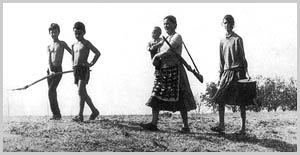
The village Prekale,
Kosovo and Metohija, September 1988 - the fate of the Serbian people: mother with sons
fleeing the Albanian terrorists
XVII The Import of Terrorism from Albania
The Third Prizren League, established in America in 1946, with the
identical program as the two previous ones - i. e. the creation of the "Greater
Albania", used all propaganda means against Yugoslavia, especially after 1948, and
after the conflict with Albania in the framework of the general confrontation and conflict
with the Kominform and with the USSR. The conflict between Yugoslavia and the Soviet Union
in 1948, made it possible to Albania to wage against Yugoslavia a combined propaganda and
diversion war.
Terrorist-diversion groups were introduced from Albania; they killed
the people from security forces, they terrorized the Serbian population. They smuggled
weapons, which represented, together with the weapons left by the Bali (the fascist
collaborators), a permanent danger of new rebellions. During all that time, the planned
actions of the Albanian nationalism were always present. They were reflected in the
permanent, chronical pressure against the Serbs, forcing them to leave the region, in the
encouragement of the demographic pressures and of the immigration of the Albanian
population. The culmination of that process was the arrival of an enormous number of
Albanian political emigrés.
|